Volume Deformation of Steam-Cured Concrete with Slag during and after Steam Curing
Abstract
1. Introduction
2. Experimental Program
2.1. Mixture Proportions of Concrete
2.2. Experimental Tests
2.2.1. Hydration Heat
2.2.2. Capillary Negative Pressure
2.2.3. Internal Relative Humidity Test
2.2.4. Porometry Assessment
2.2.5. Dynamic Elastic Modulus
3. Experimental Results
3.1. Hydration Heat of Cement Paste with and without Slag at Different Temperature
3.2. Deformation of Steam-Cured Slag Concrete
3.2.1. Deformation of Slag Concrete during Steam Curing Stage
3.2.2. Deformation of Slag Concrete after Stream Curing
3.3. Pore Size Distribution of Steam-Cured Slag Concrete
3.4. Elastic Modulus of Steam-Cured Slag Concrete
4. Discussion
4.1. Equivalent Hydration
4.2. Relationship between Shrinkage and Relative Humidity of Steam-Cured Concrete after Stream Curing
5. Conclusions
- During the steam curing process, the concrete shows an “expansion-shrinkage” pattern. After the mould is removed, the relative humidity and concrete deformation have good consistency, no matter in the fully-sealed or semi-sealed conditions. Shrinkage of concrete increases continuously with the decrease of the relative humidity. After steam curing, the main shrinkage of concrete is drying shrinkage. At 60 days, drying shrinkage accounts for over 65% of the total shrinkage. Compared with pure cement concrete, the addition of slag increases the autogenous shrinkage of concrete by 0.5–12%, and the total shrinkage increases by 1.5–8%.
- Compared with pure cement steam-cured concrete, the addition of slag reduces the hydration degree and elastic modulus of concrete. At the same time, the addition of slag increases the most probable pore diameter of cement paste, evacuates the hardened structure, and makes the pore distribution more reasonable.
- The hydration degree prediction development model of steam-cured concrete is established, and the hydration degree at any age can be calculated.
- An integrated model of concrete autogenous shrinkage and total shrinkage under steam curing conditions based on internal factors of the change of relative humidity was established. Whether shrinkage deformation is caused by cement hydration or drying, this model can better predict the deformation of concrete. In particular, the shrinkage of early age concrete is predicted. The deformation of early-age concrete is much more complicated than that of later mature concrete. This stage cannot be ignored.
Author Contributions
Funding
Institutional Review Board Statement
Informed Consent Statement
Data Availability Statement
Conflicts of Interest
References
- Shi, J.; Liu, B.; Wu, X.; Tan, J.; Dai, J.; Ji, R. Effect of steam curing on surface permeability of concrete: Multiple transmission media. J. Build. Eng. 2020, 32, 101475. [Google Scholar] [CrossRef]
- Liu, G.; Gu, T.; Xu, P.; Hong, J.; Shrestha, A.; Martek, I. A production line-based carbon emission assessment model for prefabricated components in China. J. Clean. Prod. 2018, 209, 30–39. [Google Scholar] [CrossRef]
- Sahin, S.; Orung, I.; Okuroglu, M.; Karadutlu, Y.N. Properties of prefabricated building materials produced from ground pumice aggregate and binders. Constr. Build. Mater. 2008, 22, 989–992. [Google Scholar] [CrossRef]
- Liu, G.; Yang, H.; Fu, Y.; Mao, C.; Xu, P.; Hong, J.; Li, R. Cyber-physical system-based real-time monitoring and visualization of greenhouse gas emissions of prefabricated construction. J. Clean. Prod. 2020, 246, 119059. [Google Scholar] [CrossRef]
- Ba, M.F.; Qian, C.X.; Guo, X.J.; Han, X.Y. Effects of steam curing on strength and porous structure of concrete with low water/binder ratio. Constr. Build. Mater. 2011, 25, 123–128. [Google Scholar] [CrossRef]
- Radin, M.F.M.Z.S. Physical properties of high-performance concrete with admixtures exposed to a medium temperature range 20 °C to 50 °C. Cem. Concr. Res. 2000, 30, 1283–1287. [Google Scholar]
- Ho, D.W.S.; Chua, C.W.; Tam, C.T. Steam-cured concrete incorporating mineral admixtures. Cem. Concr. Res. 2003, 33, 595–601. [Google Scholar] [CrossRef]
- Shi, J.; Liu, B.; Wu, X.; Qin, J.; Jiang, J.; He, Z. Evolution of mechanical properties and permeability of concrete during steam curing process. J. Build. Eng. 2020, 32, 101796. [Google Scholar] [CrossRef]
- Tae, G.H.; Kim, D.H. A Study on Flexural Behavior of Precast Box Culvert with Blast Slag; Palgrave Macmillan: Basingstoke, UK, 2012. [Google Scholar]
- Kim, S.W.; Jeong, C.Y.; Lee, J.S.; Kim, K.H. Applicability of Ground Granulated Blast-Furnace Slag for Precast Concrete Beams Subjected to Bending Moment. J. Asian Archit. Build. Eng. 2014, 13, 633–639. [Google Scholar] [CrossRef]
- Yan, X.; Jiang, L.; Guo, M.; Chen, Y.; Song, Z.; Bian, R. Evaluation of sulfate resistance of slag contained concrete under steam curing. Constr. Build. Mater. 2019, 195, 231–237. [Google Scholar] [CrossRef]
- Yan, X.; Jiang, L.; Xu, N.; Song, Z.; Chen, Y. Influence of steam curing on compressive fatigue performance of high-volume slag concrete. Mag. Concr. Res. 2019, 71, 773–780. [Google Scholar] [CrossRef]
- Zhang, J.; Dongwei, H.; Wei, S. Experimental study on the relationship between shrinkage and interior humidity of concrete at early age. Mag. Concr. Res. 2010, 62, 191–199. [Google Scholar] [CrossRef]
- Bissonnette, B.; Pierre, P.; Pigeon, M. Influence of key parameters on drying shrinkage of cementitious materials. Cem. Concr. Res. 1999, 29, 1655–1662. [Google Scholar] [CrossRef]
- Ayano, T.; Wittmann, F.H. Drying, moisture distribution, and shrinkage of cement-based materials. Mater. Struct. 2002, 35, 134–140. [Google Scholar] [CrossRef]
- Shen, D.; Wen, C.; Zhu, P.; Wu, Y.; Yuan, J. Influence of Barchip fiber on early-age autogenous shrinkage of high strength concrete. Constr. Build. Mater. 2020, 256, 119223. [Google Scholar] [CrossRef]
- Kovler, K.; Zhutovsky, S. Overview and Future Trends of Shrinkage Research. Mater. Struct. 2006, 39, 827. [Google Scholar] [CrossRef]
- Liu, Y.; Tafsirojjaman, T.; Dogar, A.U.R.; Hückler, A. Shrinkage behavior enhancement of infra-lightweight concrete through FRP grid reinforcement and development of their shrinkage prediction models. Constr. Build. Mater. 2020, 258, 119649. [Google Scholar] [CrossRef]
- Shah, M.I.; Amin, M.N.; Khan, K.; Sohaib, M.; Mosavi, A. Performance Evaluation of Soft Computing for Modeling the Strength Properties of Waste Substitute Green Concrete. Sustainability 2021, 13, 2867. [Google Scholar] [CrossRef]
- Zhang, J.; Hou, D.; Han, Y. Micromechanical modeling on autogenous and drying shrinkages of concrete. Constr. Build. Mater. 2012, 29, 230–240. [Google Scholar] [CrossRef]
- Lura, P. Autogenous Deformation and Internal Curing of Concrete; OAI: New York, NY, USA, 2003. [Google Scholar]
- Darquennes, A.; Staquet, S.; Delplancke-Ogletree, M.P.; Espion, B. Effect of autogenous deformation on the cracking risk of slag cement concretes. Cem. Concr. Compos. 2011, 33, 368–379. [Google Scholar] [CrossRef]
- Jensen, O.M.; Lura, P.; Goodwin, F.; Bentz, D.; Hooton, D.; Kovler, K.; Weiss, J. Standard Test Method for Autogenous Strain of Cement Paste and Mortar. In Proceedings of International Conference of Logistics Engineering & Management; ASTM: West Conshohocken, PA, USA, 2007. [Google Scholar]
- Miao, C.-W.; Tian, Q.; Sun, W.; Liu, J.-P. Water consumption of the early-age paste and the determination of “time-zero” of self-desiccation shrinkage. Cem. Concr. Res. 2007, 37, 1496–1501. [Google Scholar]
- Young, J.F. Humidity Control in the Laboratory Using Salt Solutions—A Review. J. Chem. Technol. Biotechnol. Biotechnol. 2010, 17, 241–245. [Google Scholar] [CrossRef]
- Zhao, H.; Jiang, K.; Yang, R.; Tang, Y.; Liu, J. Experimental and theoretical analysis on coupled effect of hydration, temperature and humidity in early-age cement-based materials. Int. J. Heat Mass Transf. 2020, 146, 118748. [Google Scholar] [CrossRef]
- Zhao, H.; Wu, X.; Huang, Y.; Zhang, P.; Tian, Q.; Liu, J. Investigation of moisture transport in cement-based materials using low-field nuclear magnetic resonance imaging. Mag. Concr. Res. 2021, 73, 252–270. [Google Scholar] [CrossRef]
- Zhao, H.; Qin, X.; Liu, J.; Zhou, L.; Tian, Q.; Wang, P. Pore structure characterization of early-age cement pastes blended with high-volume fly ash. Constr. Build. Mater. 2018, 189, 934–946. [Google Scholar] [CrossRef]
- An-Ming, S.; Wu, Y.; Wan-Cheng, Y. Evolution of distribution and content of water in cement paste by low field nuclear magnetic resonance. J. Cent. South Univ. 2013, 20, 1109–1114. [Google Scholar]
- Lu, X.; Sun, Q.; Feng, W.; Tian, J. Evaluation of dynamic modulus of elasticity of concrete using impact-echo method. Constr. Build. Mater. 2013, 47, 231–239. [Google Scholar] [CrossRef]
- Carette, J.; Stephanie, S. Monitoring and modelling the early age and hardening behaviour of eco-concrete through continuous non-destructive measurements: Part II. Mechanical behaviour. Cem. Concr. Compos. 2016, 73, 1–9. [Google Scholar] [CrossRef]
- Han, S.H.; Kim, J.K. Effect of temperature and age on the relationship between dynamic and static elastic modulus of concrete. Cem. Concr. Res. 2004, 34, 1219–1227. [Google Scholar] [CrossRef]
- Xu, G. Study on Early Cracking Behavior of Concrete with Large Amount of Industrial Waste Residue; Southeast University: Nanjing, China, 2018. [Google Scholar]
- Su, A. Research on Early Shrinkage Performance and Cracking Tendency of High Performance Concrete; Harbin Institute of Technology: Harbin, China, 2008. [Google Scholar]
- Wang, P. Study on the Effect of High Temperature Fire on Silane Protection of Concrete; Qingdao University of Technology: Qingdao, China, 2010. [Google Scholar]
- Shkolnik, I.E. Effect of nonlinear response of concrete on its elastic modulus and strength. Cem. Concr. Compos. 2005, 27, 747–757. [Google Scholar] [CrossRef]
- Shkolnik, I.E. Influence of high strain rates on stress–strain relationship, strength and elastic modulus of concrete. Cem. Concr. Compos. 2008, 30, 1000–1012. [Google Scholar] [CrossRef]
- Shao, S. Research on Cracking Mechanism of Steam-Cured Concrete Products; Qingdao University of Technology: Qingdao, China, 2020. [Google Scholar]
- Escadeillas, G.; Aubert, J.E.; Segerer, M.; Prince, W. Some factors affecting delayed ettringite formation in heat-cured mortars. Cem. Concr. Res. 2007, 37, 1445–1452. [Google Scholar] [CrossRef]
- Tosun, K. Effect of SO3 content and fineness on the rate of delayed ettringite formation in heat cured Portland cement mortars. Cem. Concr. Compos. 2006, 28, 761–772. [Google Scholar] [CrossRef]
- Lura, P.; Jensen, O.M.; Breugel, K.V. Autogenous shrinkage in high-performance cement paste: An evaluation of basic mechanisms. Cem. Concr. Res. 2003, 33, 223–232. [Google Scholar] [CrossRef]
- Princigallo, A.; Lura, P.; Breugel, K.V.; Levita, G. Early development of properties in a cement paste: A numerical and experimental study. Cem. Concr. Res. 2003, 33, 1013–1020. [Google Scholar] [CrossRef]
- Liu, R. Hydration Mechanism and Long-Term Properties of Cement-Slag Composite Cementing Materials; Tsinghua University: Beijing, China, 2013. [Google Scholar]
- Jensen, O.M. Thermodynamic limitation of self-desiccation. Cem. Concr. Res. 1995, 25, 157–164. [Google Scholar] [CrossRef]
- Jensen, O.M.; Hansen, P.F. Influence of temperature on autogenous deformation and relative humidity change in hardening cement paste. Cem. Concr. Res. 1999, 29, 567–575. [Google Scholar] [CrossRef]
- Zheng, Z. Influence Factors and Theoretical Analysis of Crack Resistance of High Strength and High Performance Concrete; Fuzhou University: Fuzhou, China, 2003. [Google Scholar]
- Bhattacharja, S.; Moukwa, M.; D’Orazio, F.; Jehng, J.Y.; Halperin, W.P. Microstructure determination of cement pastes by NMR and conventional techniques. Adv. Cem. Based Mater. 2016, 1, 67–76. [Google Scholar] [CrossRef]
- Hou, D.; Zhao, T.; Ma, H.; Li, Z. Reactive Molecular Simulation on Water Confined in the Nanopores of the Calcium Silicate Hydrate Gel: Structure, Reactivity, and Mechanical Properties. J. Phys. Chem. C 2015, 119, 1346–1358. [Google Scholar] [CrossRef]
- Zhang, Q.; Ye, G.; Koenders, E. Investigation of the structure of heated Portland cement paste by using various techniques. Constr. Build. Mater. 2013, 38, 1040–1050. [Google Scholar] [CrossRef]
- Supit, S.W.M.; Shaikh, F.U.A. Durability properties of high volume fly ash concrete containing nano-silica. Mater. Struct. 2015, 48, 2431–2445. [Google Scholar] [CrossRef]
- Wang, Q.; Wang, D.; Chen, H. The role of fly ash microsphere in the microstructure and macroscopic properties of high-strength concrete. Cem. Concr. Compos. 2017, 83, 125–137. [Google Scholar] [CrossRef]
- Corinaldesi, V.; Moriconi, G. Influence of mineral additions on the performance of 100% recycled aggregate concrete. Constr. Build. Mater. 2009, 23, 2869–2876. [Google Scholar] [CrossRef]
- Standardization, E.C.F. Design of Concrete Structures, Part 1: General Rules and Rules for Buildings. Eurocode 2; CEN: Brussels, Belgium, 1992. [Google Scholar]
- Pane, I.; Hansen, W. Concrete Hydration and Mechanical Properties under Nonisothermal Conditions. ACI Mater. J. 2002, 99, 534–542. [Google Scholar]
- Schindler, A.K. Effect of Temperature on Hydration of Cementitious Materials. ACI Mater. J. 2004, 101, 72–81. [Google Scholar]
- Wade, S.A.; Nixon, J.M.; Schindler, A.K.; Barnes, R.W. Effect of Temperature on the Setting Behavior of Concrete. J. Mater. Civ. Eng. 2010, 22, 214–222. [Google Scholar] [CrossRef]
- Carette, J.; Stephanie, S. Monitoring and modelling the early age and hardening behaviour of eco-concrete through continuous non-destructive measurements: Part I. Hydration and apparent activation energy. Cem. Concr. Compos. 2016, 73, 10–18. [Google Scholar] [CrossRef]
- Dannhauser, W. Heat of hydration. J. Chem. Educ. 1971, 48, 329. [Google Scholar] [CrossRef]
- Wang, X.Y.; Lee, H.S. Simulation of a temperature rise in concrete incorporating fly ash or slag. Mater. Struct. 2010, 43, 737–754. [Google Scholar] [CrossRef]
- Cervera, M.; Oliver, J.; Prato, T. Thermo-Chemo-Mechanical Model for Concrete. I: Hydration and Aging. J. Eng. Mech. 1999, 125, 1018–1027. [Google Scholar] [CrossRef]
- Bentz, D.P.; Garboczi, E.J.; Quenard, D.A. Modelling drying shrinkage in reconstructed porous materials: Application to porous Vycor glass. Model. Simul. Mater. Sci. Eng. 1999, 6, 211. [Google Scholar] [CrossRef]
- Zhao, H.T.; Liu, J.P.; Yin, X.L.; Wang, Y.; Huang, D.H. A multiscale prediction model and simulation for autogenous shrinkage deformation of early-age cementitious materials. Constr. Build. Mater. 2019, 215, 482–493. [Google Scholar] [CrossRef]
- Koniorczyk, M.; Gawin, D. Modelling of salt crystallization in building materials with microstructure—Poromechanical approach. Constr. Build. Mater. 2012, 36, 860–873. [Google Scholar] [CrossRef]
- Powers, T.C. Studies of the Physical Properties of Hardened Portland Cement Pastes. J. ACI 1948, 43, 101–132. [Google Scholar]
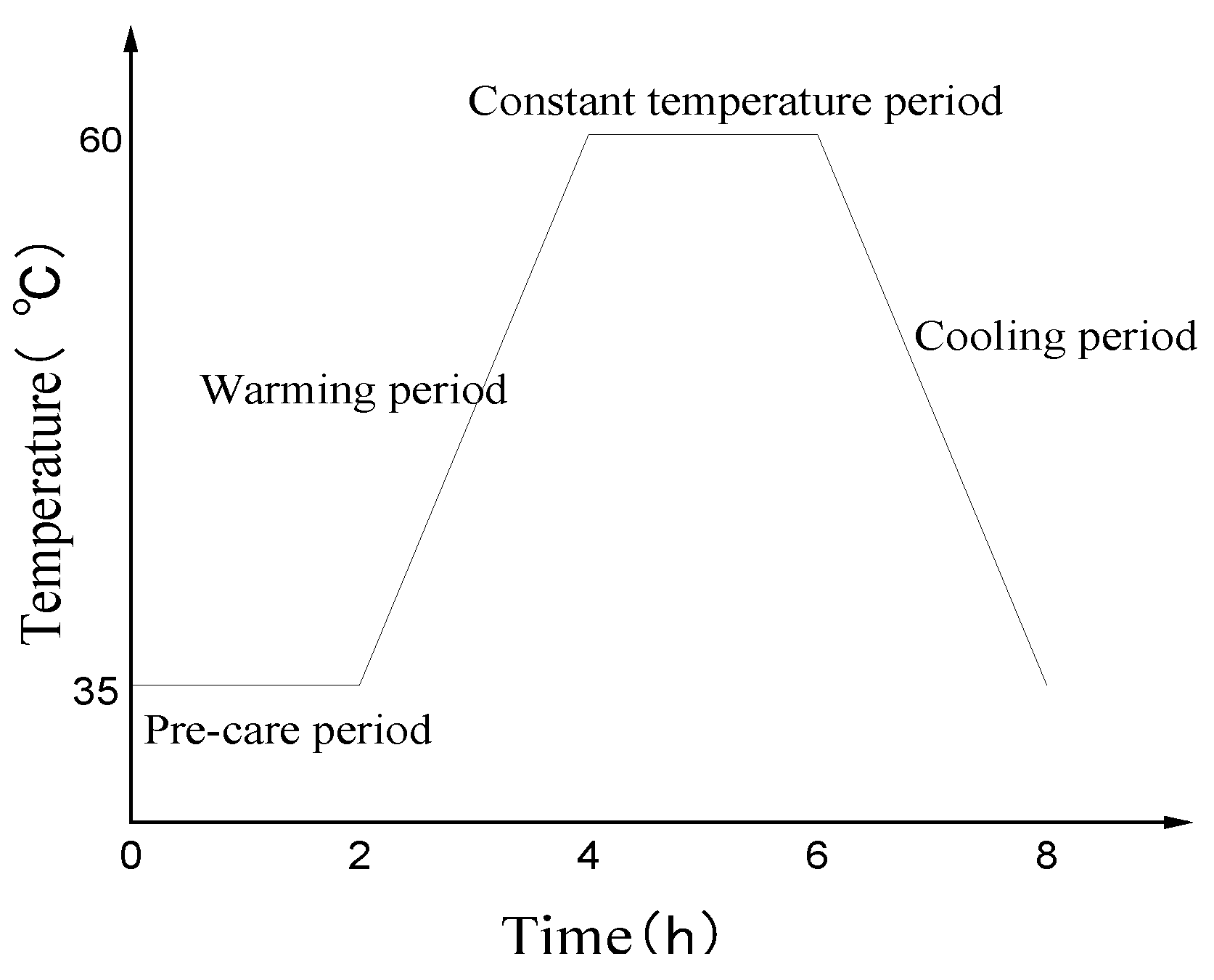
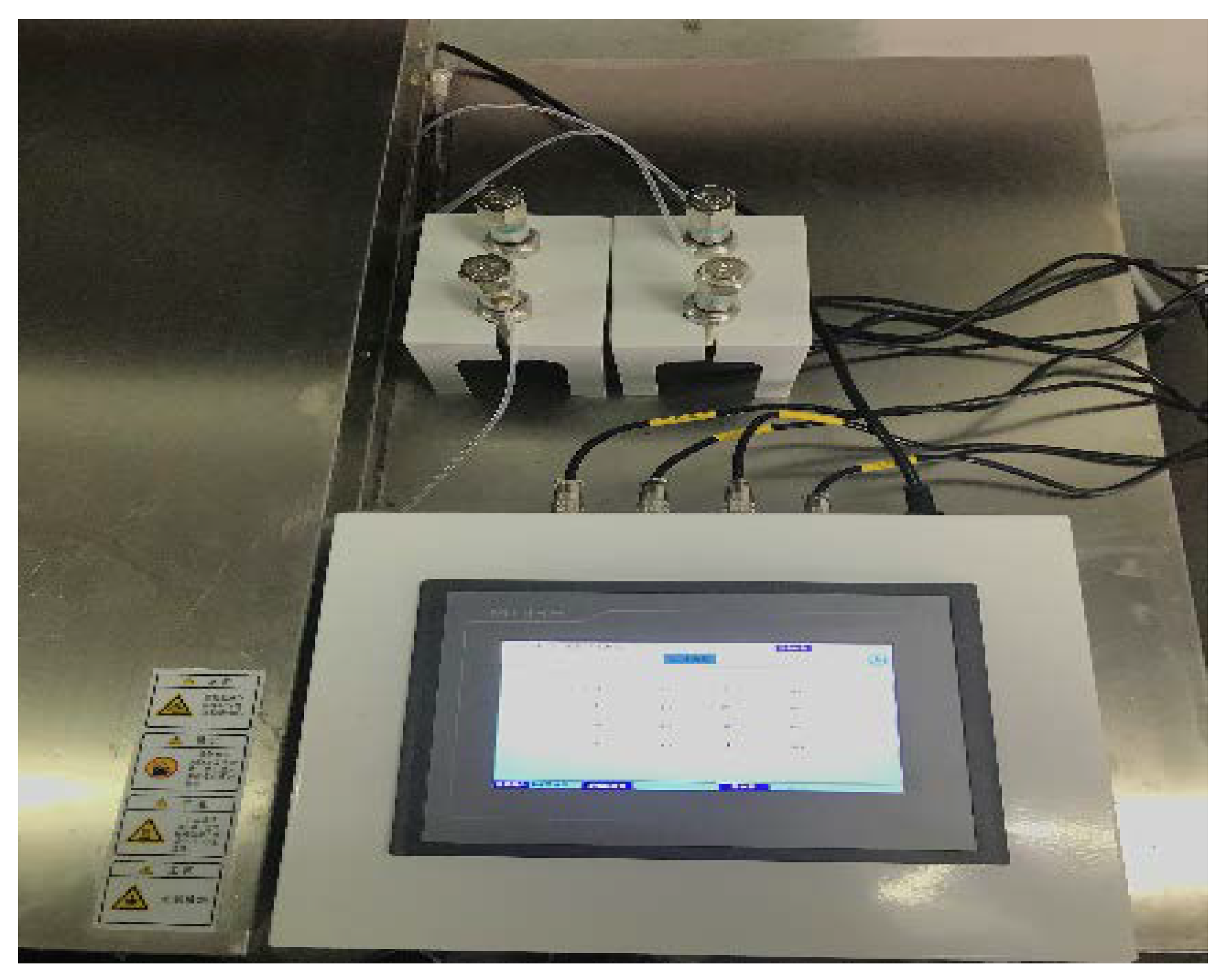
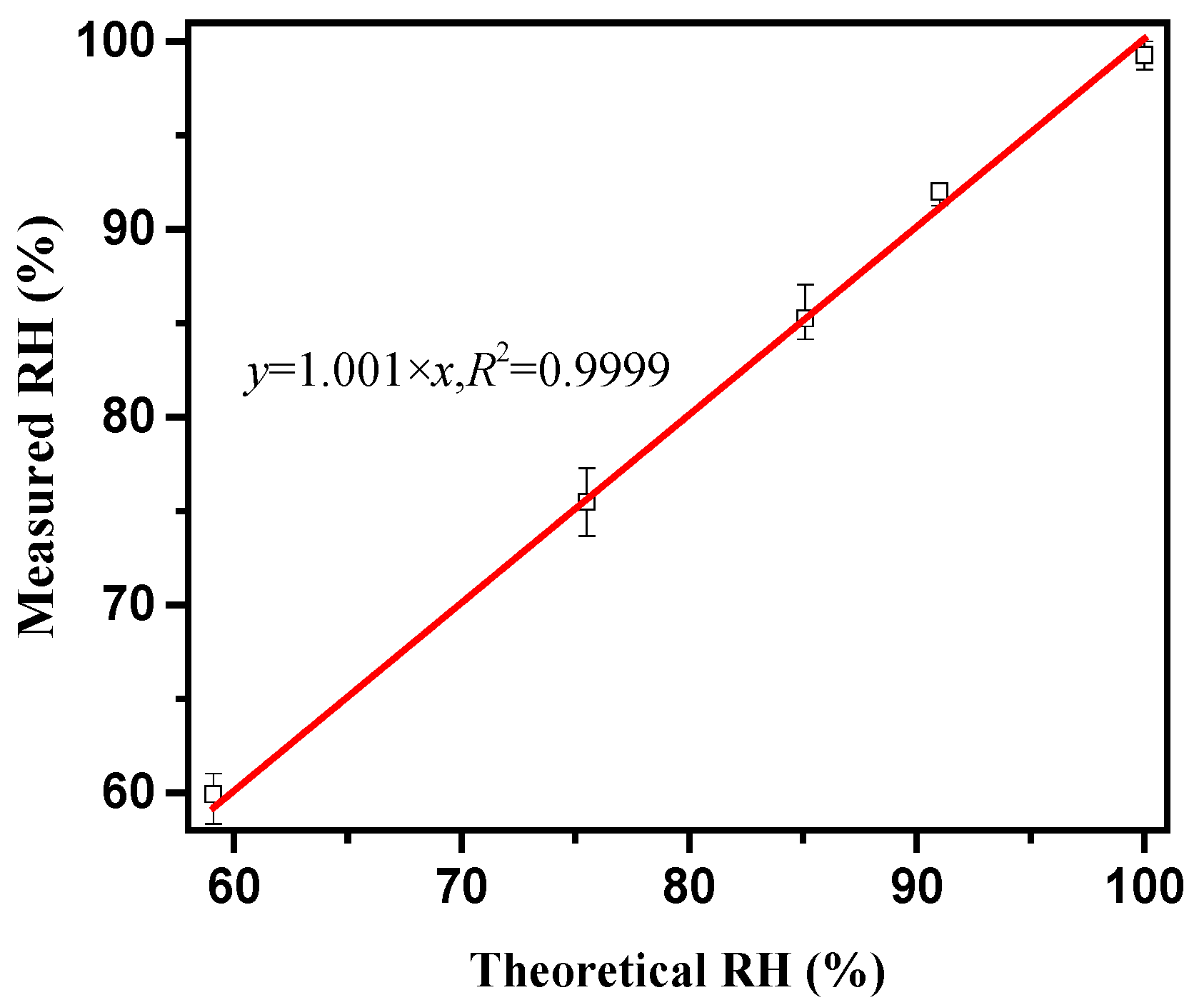
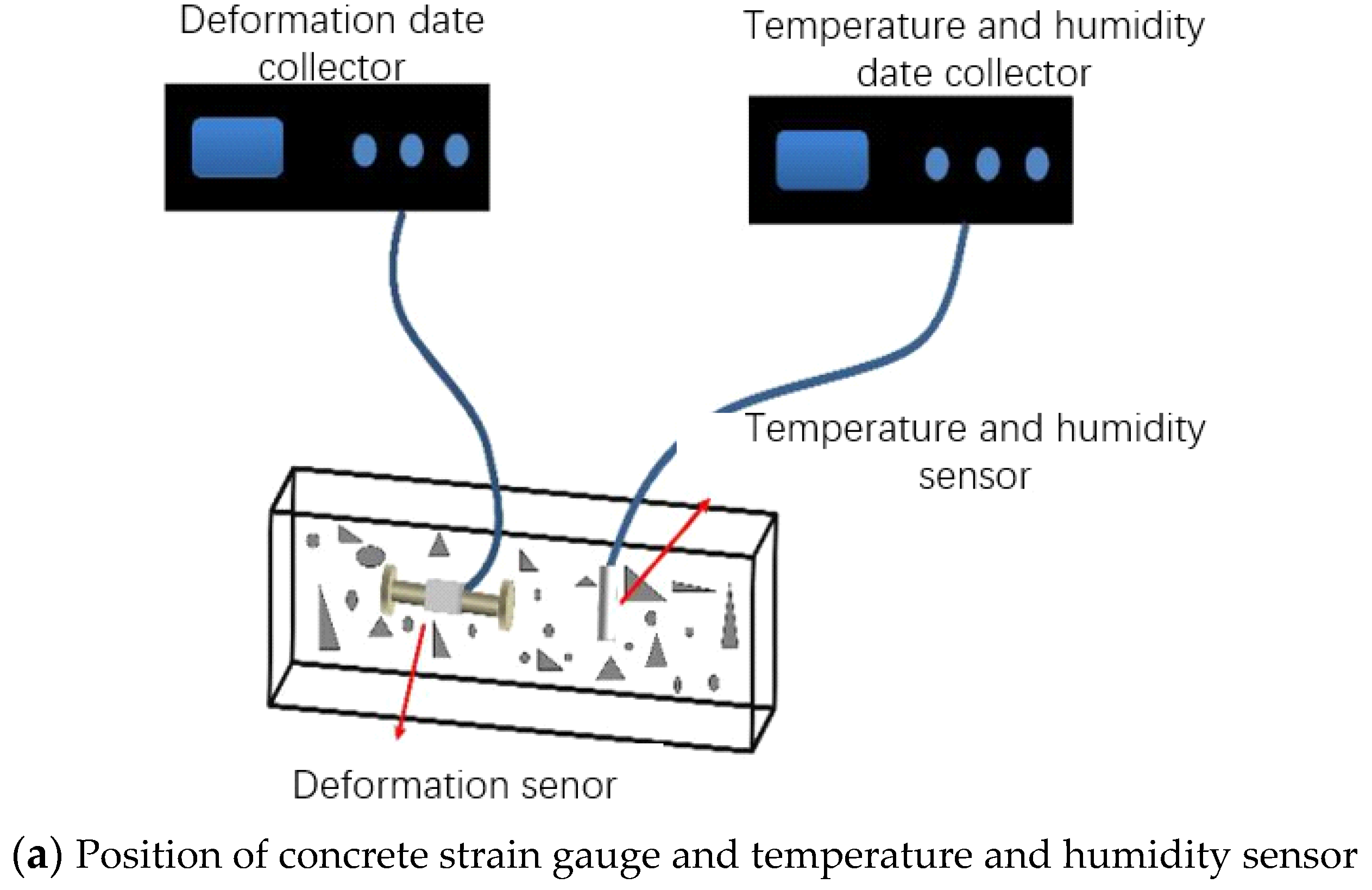
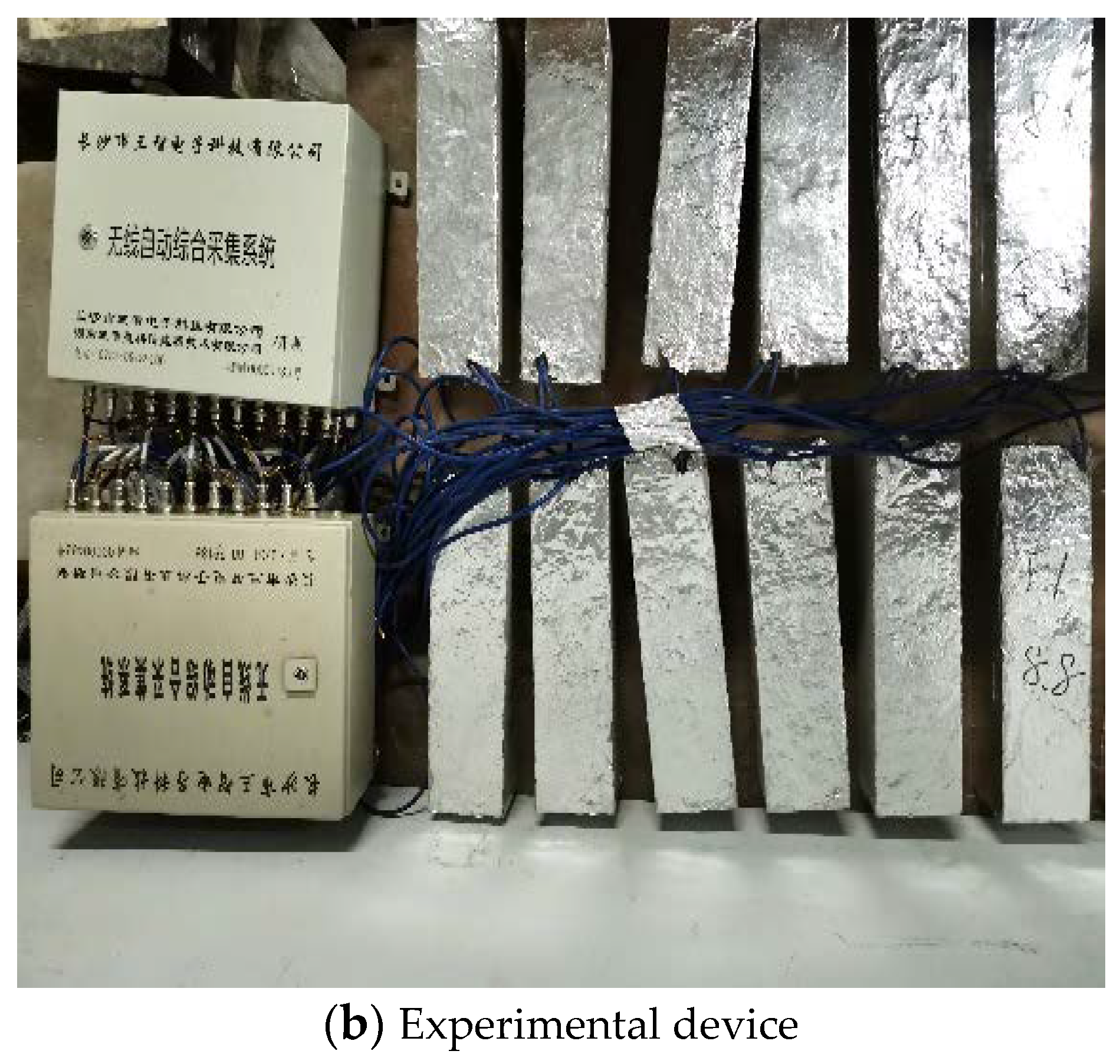

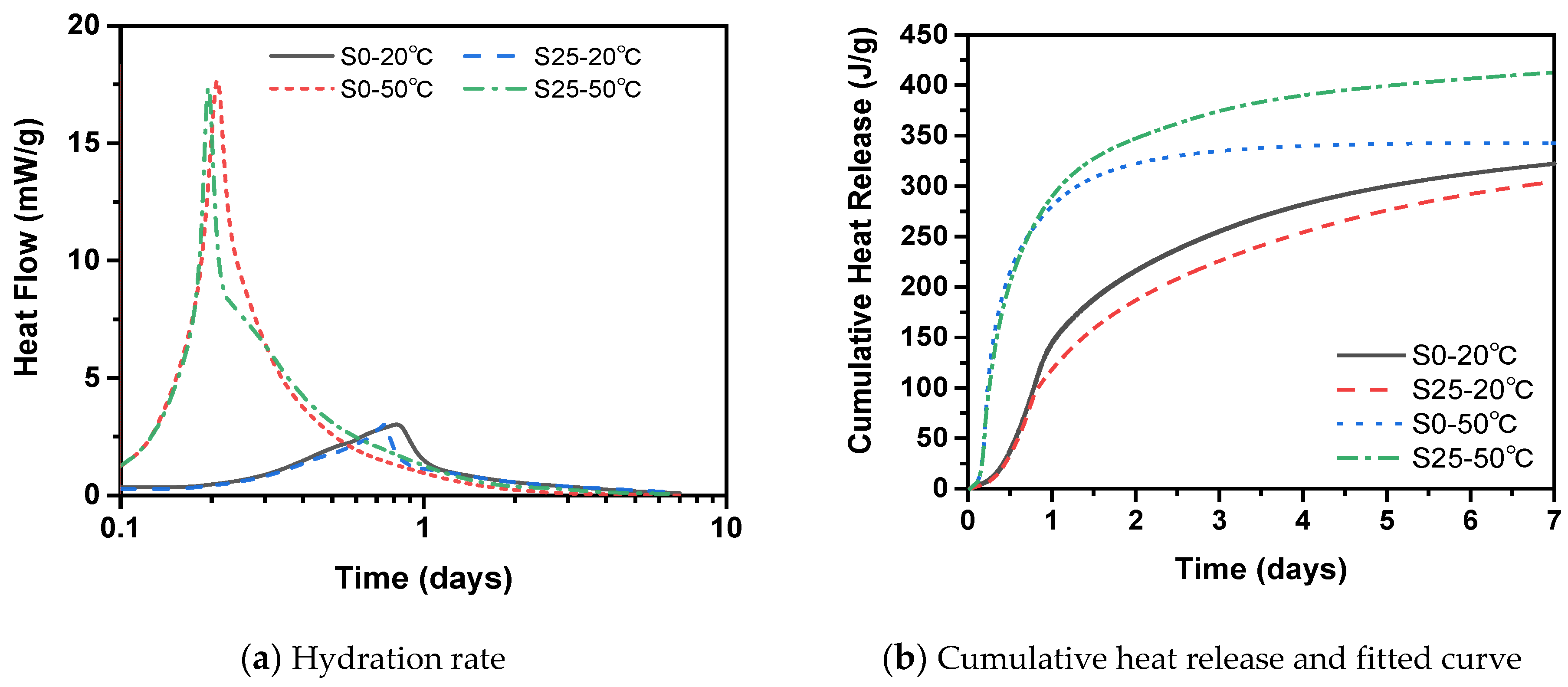
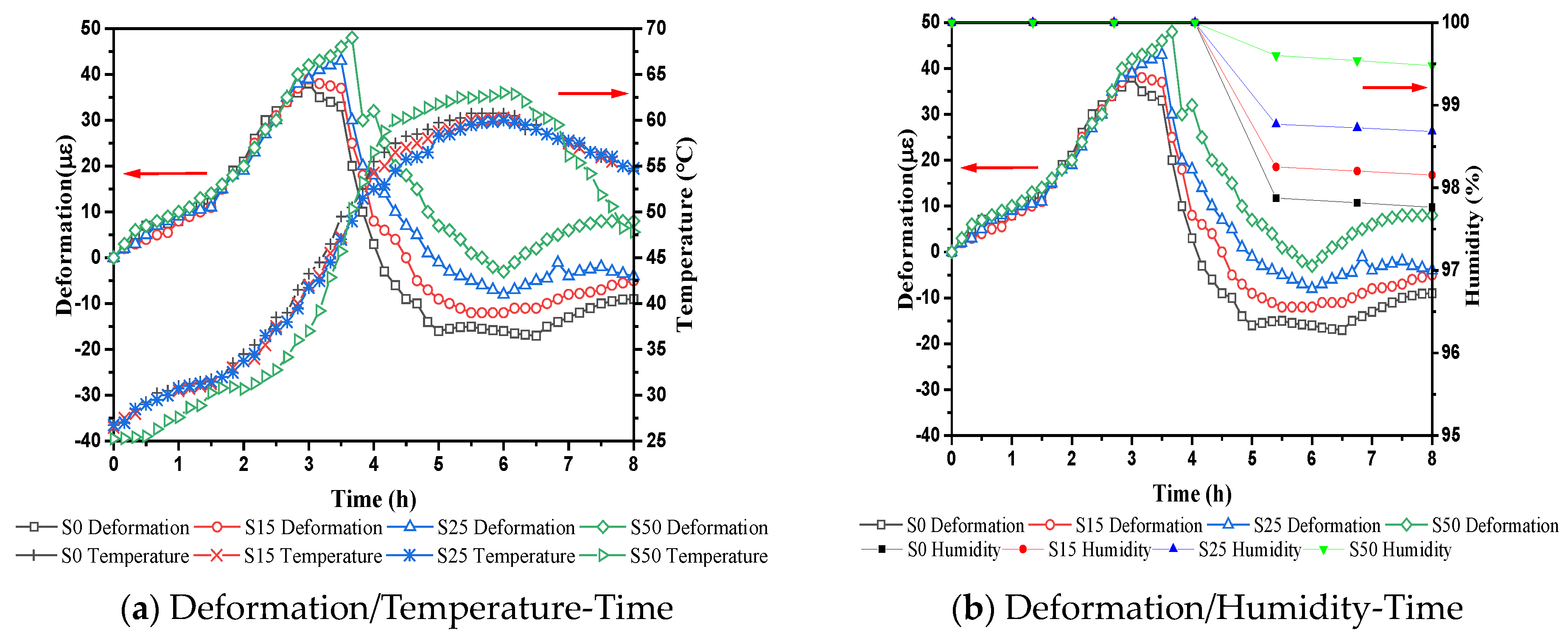
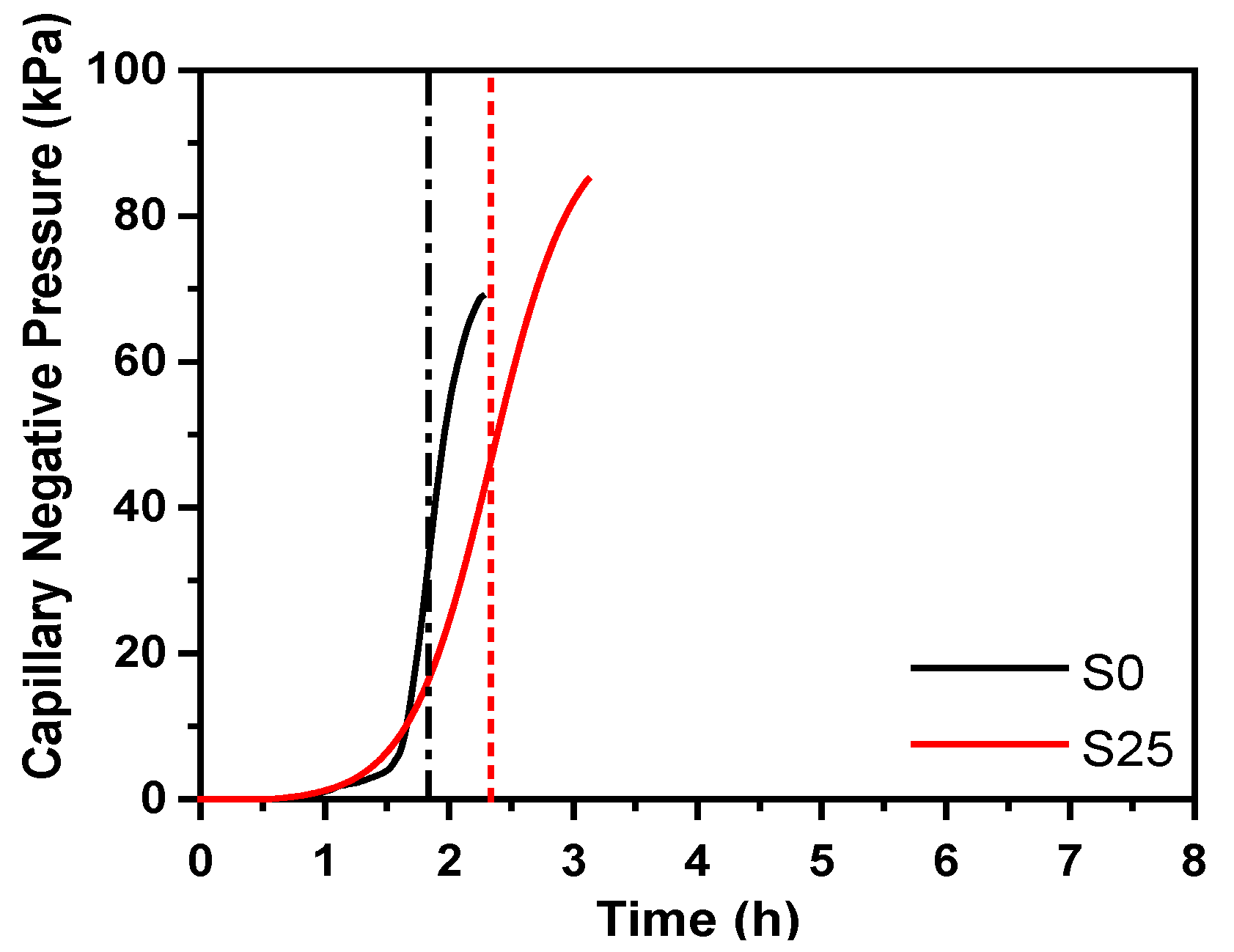
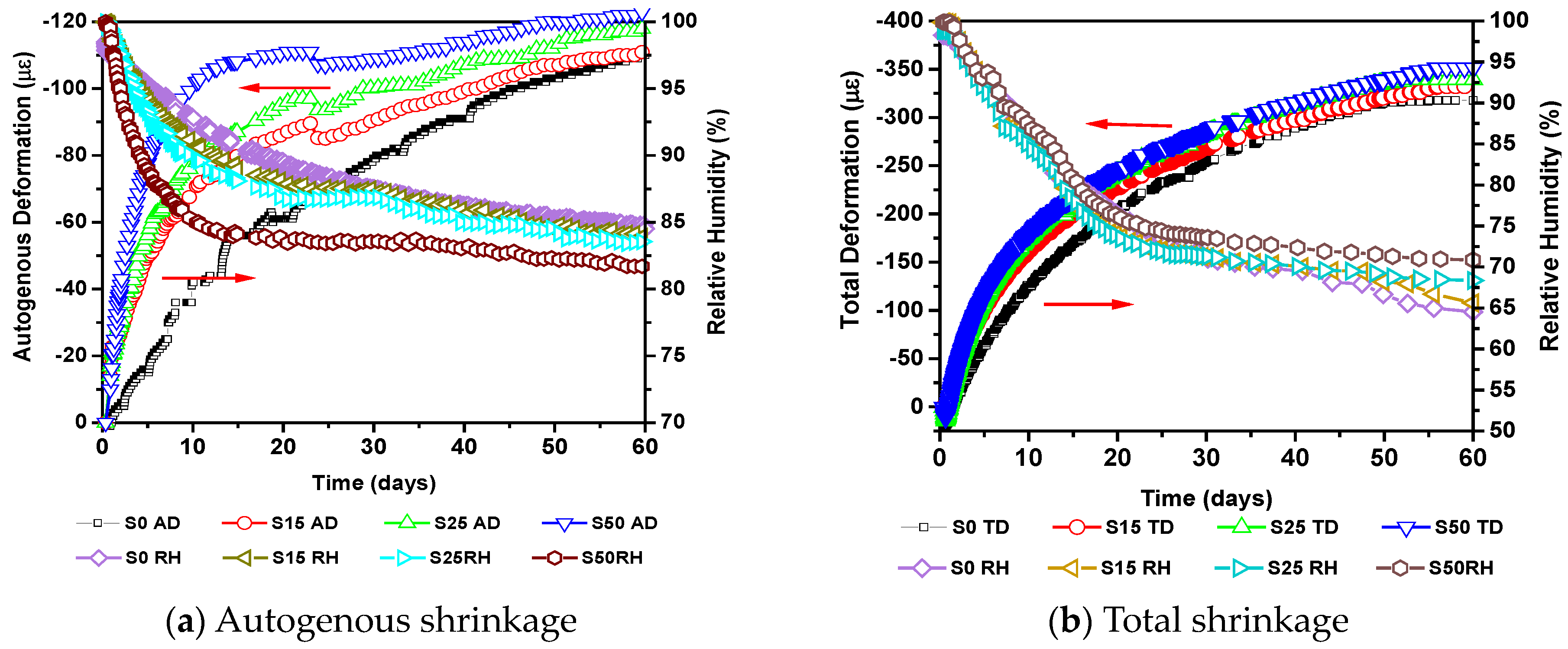


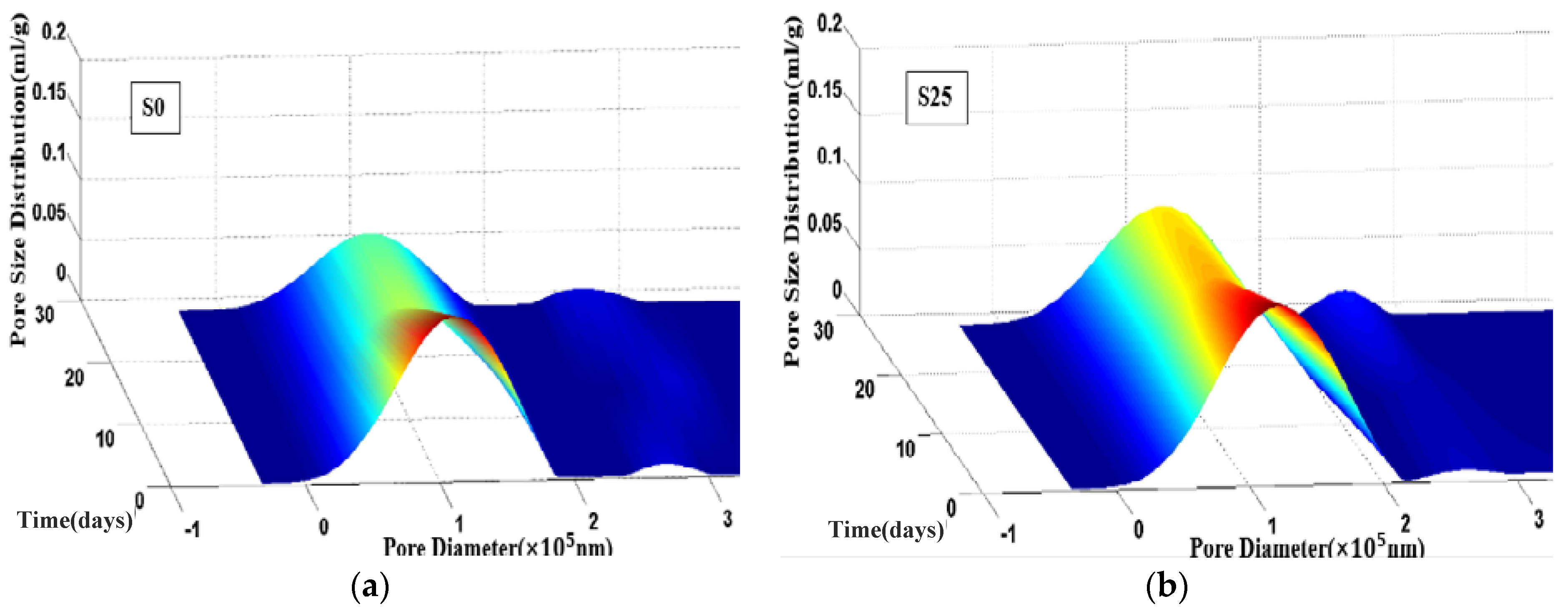
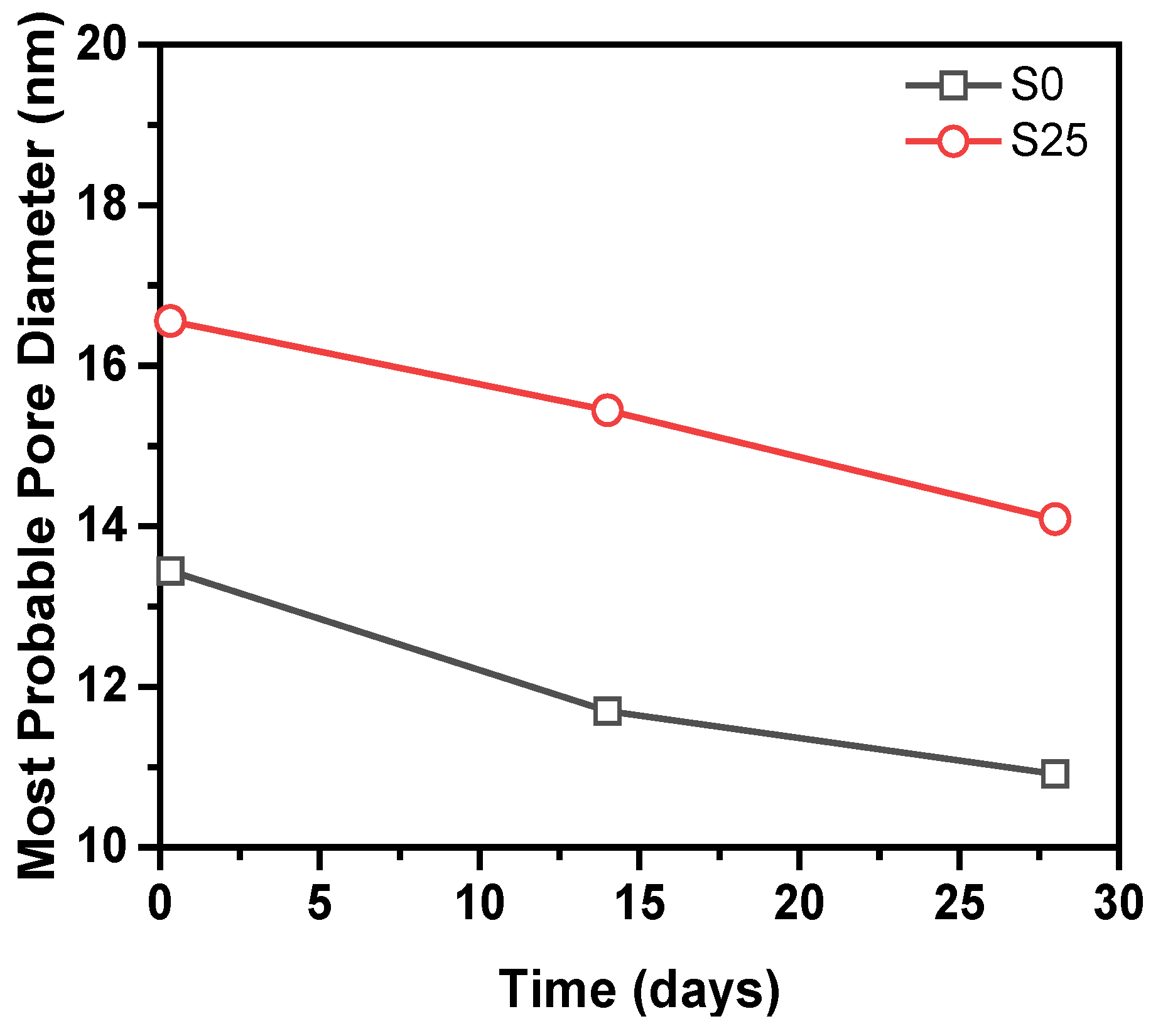
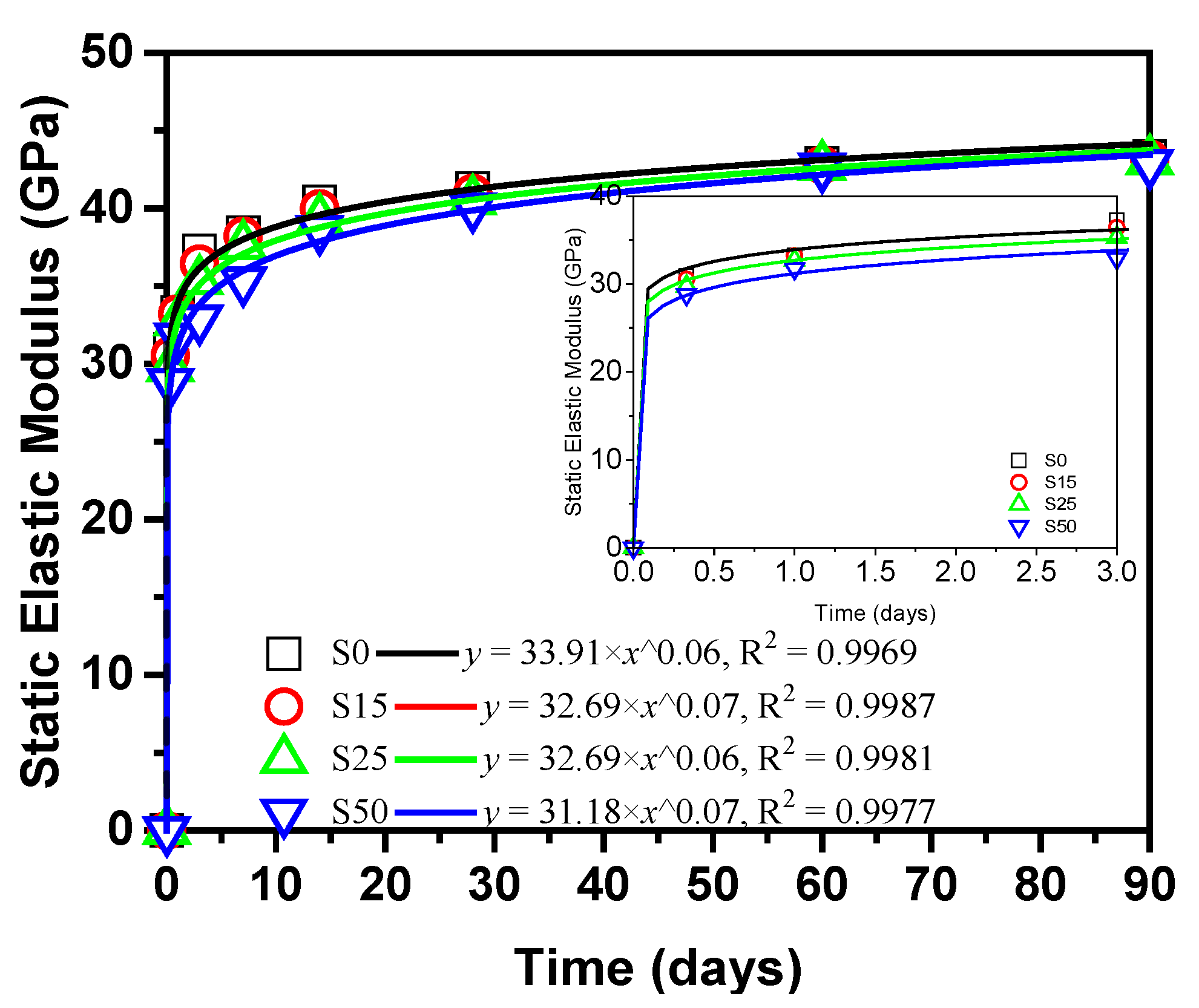
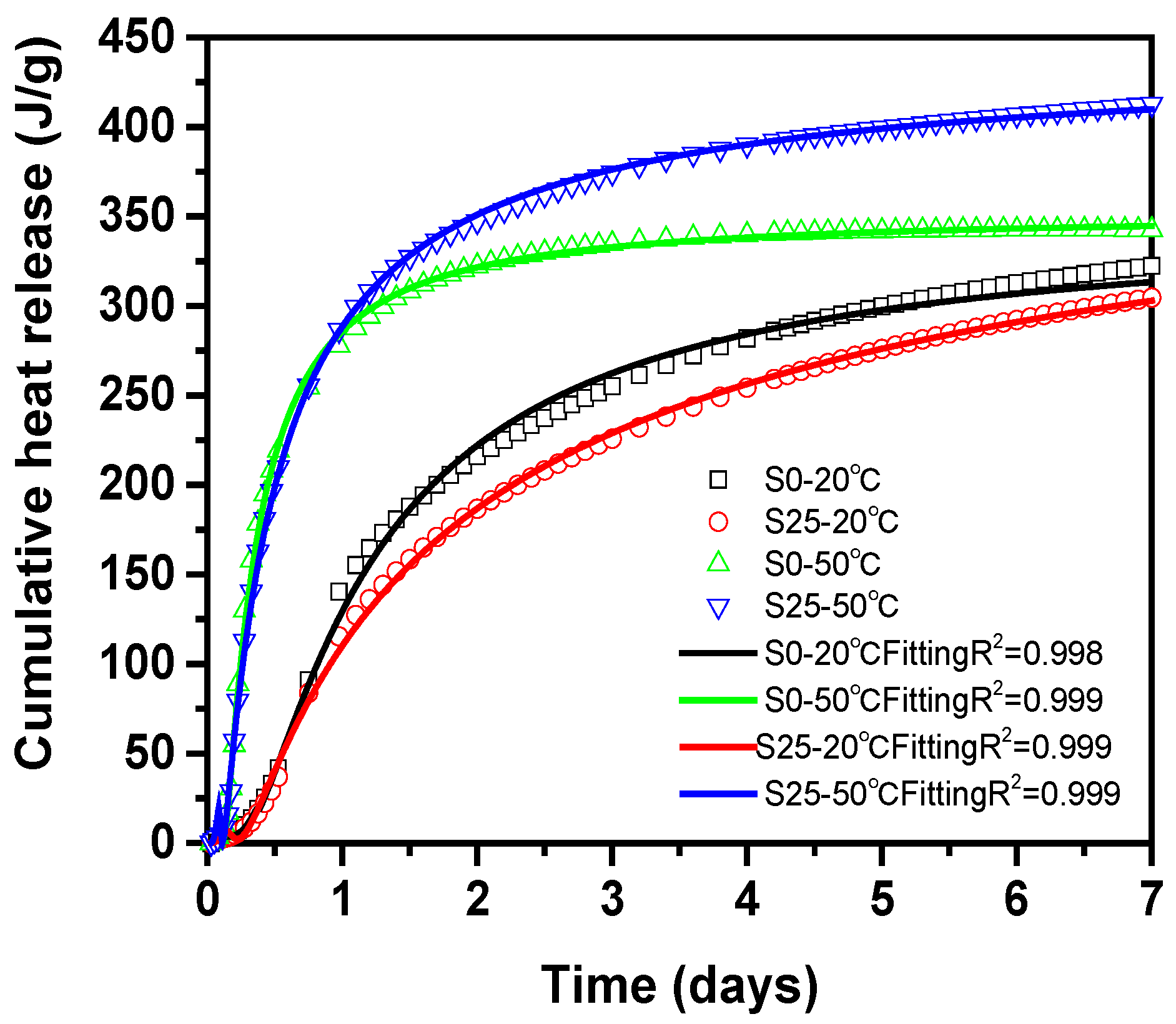
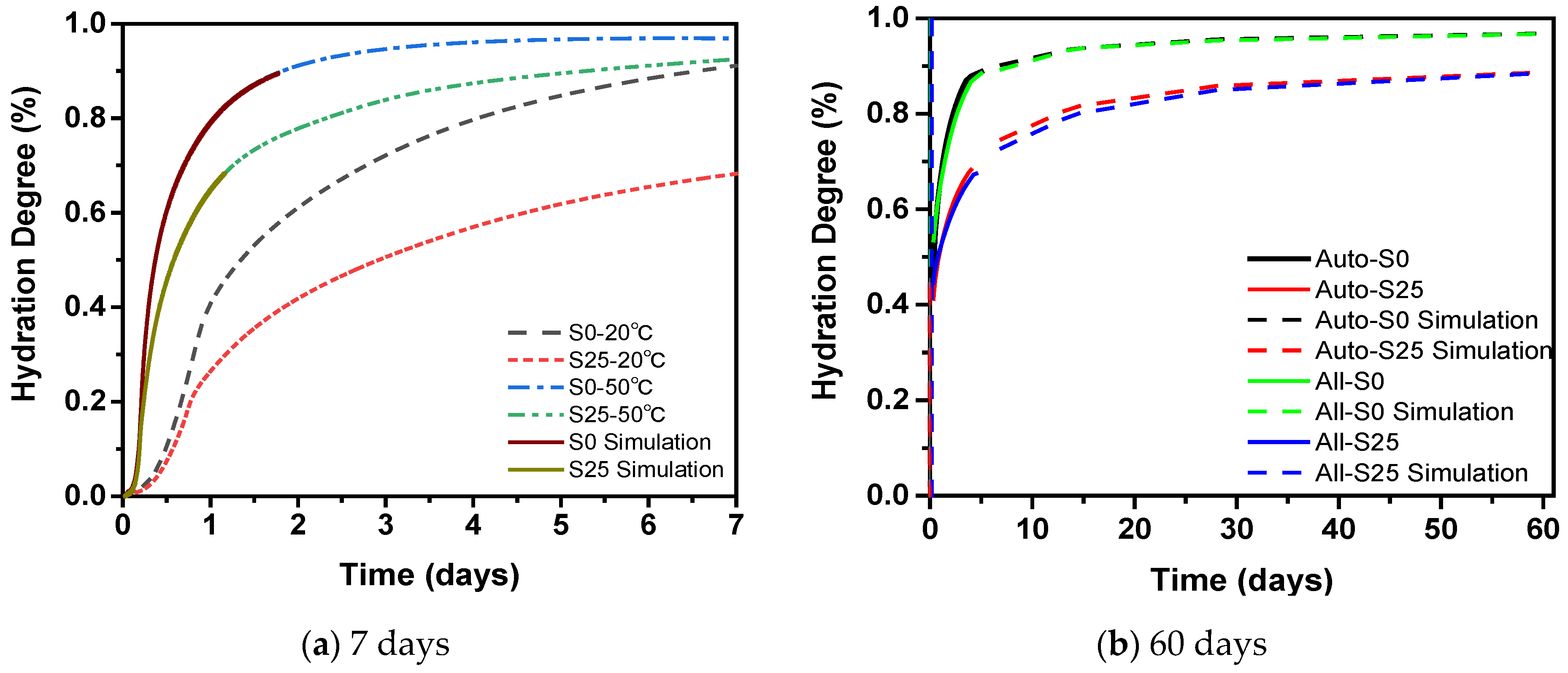

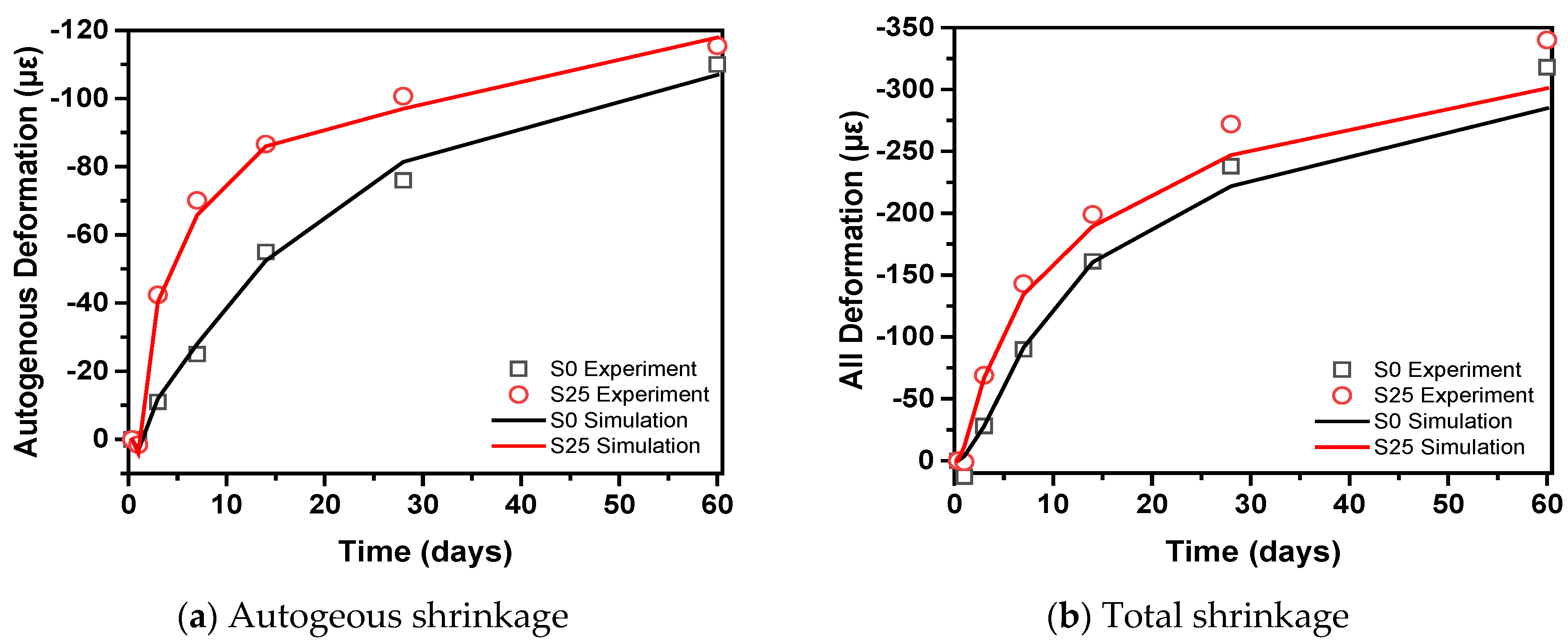
| Raw Materials | SiO2 | Al2O3 | Fe2O3 | CaO | MgO | SO3 | TiO2 | Na2O | K2O |
|---|---|---|---|---|---|---|---|---|---|
| Cement | 19.95 | 4.83 | 2.93 | 65.71 | 2.95 | 2.28 | 0.34 | 0.21 | 0.8 |
| Slag | 30.15 | 15.53 | 0.43 | 41.94 | 7.89 | 2.22 | 0.82 | 0.56 | 0.46 |
| No. | Cement | Slag | Sand | Aggregate | Water | Superplasticizer |
|---|---|---|---|---|---|---|
| S0 | 460 | 0 | 780 | 1021 | 145 | 5.06 |
| S15 | 391 | 69 | 780 | 1021 | 145 | 5.06 |
| S25 | 345 | 115 | 780 | 1021 | 145 | 5.06 |
| S50 | 230 | 230 | 780 | 1021 | 145 | 5.06 |
| T (°C) | NaBr | NaCl | KCl | BaCl2 | Distilled Water |
|---|---|---|---|---|---|
| 20 | 59.1 | 75.5 | 85.1 | 90.0 | 100 |
| Parameters | S0–20 °C | S0–50 °C | S25–20 °C | S25–50 °C |
|---|---|---|---|---|
| a1 | 350.250 | 418.202 | 496.181 | 498.779 |
| a2 | 3.545 | −64.782 | −49.779 | −49.857 |
| a1 + a2 | 353.795 | 353.420 | 446.622 | 445.922 |
Publisher’s Note: MDPI stays neutral with regard to jurisdictional claims in published maps and institutional affiliations. |
© 2021 by the authors. Licensee MDPI, Basel, Switzerland. This article is an open access article distributed under the terms and conditions of the Creative Commons Attribution (CC BY) license (http://creativecommons.org/licenses/by/4.0/).
Share and Cite
Han, X.; Fu, H.; Li, G.; Tian, L.; Pan, C.; Chen, C.; Wang, P. Volume Deformation of Steam-Cured Concrete with Slag during and after Steam Curing. Materials 2021, 14, 1647. https://doi.org/10.3390/ma14071647
Han X, Fu H, Li G, Tian L, Pan C, Chen C, Wang P. Volume Deformation of Steam-Cured Concrete with Slag during and after Steam Curing. Materials. 2021; 14(7):1647. https://doi.org/10.3390/ma14071647
Chicago/Turabian StyleHan, Xiaofeng, Hua Fu, Gege Li, Li Tian, Chonggen Pan, Chunlei Chen, and Penggang Wang. 2021. "Volume Deformation of Steam-Cured Concrete with Slag during and after Steam Curing" Materials 14, no. 7: 1647. https://doi.org/10.3390/ma14071647
APA StyleHan, X., Fu, H., Li, G., Tian, L., Pan, C., Chen, C., & Wang, P. (2021). Volume Deformation of Steam-Cured Concrete with Slag during and after Steam Curing. Materials, 14(7), 1647. https://doi.org/10.3390/ma14071647






